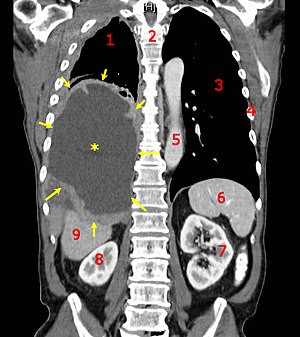Malignancies
| Cancer | |
|---|---|
| Synonyms | Malignant tumor, malignant neoplasm |
 |
|
| A coronal CT scan showing a malignant mesothelioma Legend: → tumor ←, ✱ central pleural effusion, 1 & 3 lungs, 2 spine, 4 ribs, 5 aorta, 6 spleen, 7 & 8 kidneys, 9 liver. |
|
| Pronunciation | |
| Specialty | Oncology |
| Symptoms | Lump, abnormal bleeding, prolonged cough, unexplained weight loss, change in bowel movements |
| Causes | Tobacco, obesity, poor diet, lack of physical activity, excessive alcohol, certain infections |
| Treatment | Radiation therapy, surgery, chemotherapy, and targeted therapy. |
| Prognosis | Average five year survival 66% (USA) |
| Frequency | 90.5 million (2015) |
| Deaths | 8.8 million (2015) |
| Classification |
· ·
|
|---|---|
| External resources |
Cancer is a group of diseases involving abnormal cell growth with the potential to invade or spread to other parts of the body. Not all tumors are cancerous; benign tumors do not spread to other parts of the body. Possible signs and symptoms include a lump, abnormal bleeding, prolonged cough, unexplained weight loss, and a change in bowel movements. While these symptoms may indicate cancer, they may have other causes. Over 100 types of cancers affect humans.
Tobacco use is the cause of about 22% of cancer deaths. Another 10% is due to obesity, poor diet, lack of physical activity, and excessive drinking of alcohol. Other factors include certain infections, exposure to ionizing radiation and environmental pollutants. In the developing world nearly 20% of cancers are due to infections such as hepatitis B, hepatitis C and human papillomavirus infection. These factors act, at least partly, by changing the genes of a cell. Typically many genetic changes are required before cancer develops. Approximately 5–10% of cancers are due to inherited genetic defects from a person's parents. Cancer can be detected by certain signs and symptoms or screening tests. It is then typically further investigated by medical imaging and confirmed by biopsy.
Many cancers can be prevented by not smoking, maintaining a healthy weight, not drinking too much alcohol, eating plenty of vegetables, fruits and whole grains, vaccination against certain infectious diseases, not eating too much processed and red meat, and avoiding too much sunlight exposure. Early detection through screening is useful for cervical and colorectal cancer. The benefits of screening in breast cancer are controversial. Cancer is often treated with some combination of radiation therapy, surgery, chemotherapy, and targeted therapy. Pain and symptom management are an important part of care. Palliative care is particularly important in people with advanced disease. The chance of survival depends on the type of cancer and extent of disease at the start of treatment. In children under 15 at diagnosis the five-year survival rate in the developed world is on average 80%. For cancer in the United States the average five-year survival rate is 66%.
...
Wikipedia
